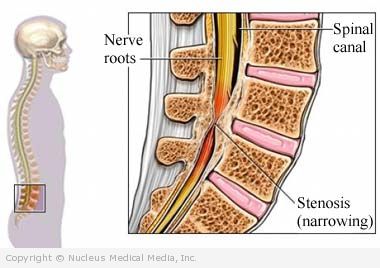Spinal stenosis
Spinal stenosis – Definition
Spinal stenosis is a narrowing of the spinal canal. The spinal canal is located within the backbone. It is a small space that holds the nerve roots and spinal cord. If this space becomes smaller, it can squeeze the nerves and the spinal cord. This causes pain and other symptoms. Stenosis can occur anywhere along the spinal cord. It is most common in the low back (lumbar) region.
Spinal stenosis – Causes
Some people are born with narrowed canals. Most often stenosis is a result of aging. Conditions that can cause spinal stenosis include:
- Osteoarthritis and osteophytes (bony spurs) associated with aging
- Rheumatoid arthritis
- Spinal tumors
- Trauma
- Paget’s disease of the bone
- Previous surgery
Spinal stenosis – Risk Factors
Factors that increase your chance of spinal stenosis include:
- Being born with a narrow spinal canal
- Age: 50 or older
- Previous injury or surgery of the spine
Spinal stenosis – Symptoms
Symptoms include:
- Numbness, weakness, cramping, or pain in the legs and thighs
- Radiating pain down the leg
- Abnormal bowel and/or bladder function
- Decreased sensation in the feet causing difficulty placing the feet when walking
- Loss of sexual function
- Partial or complete paralysis of legs
Spinal stenosis – Diagnosis
Your doctor will ask about your symptoms and medical history. A physical exam will be done.
Tests may include:
- X-ray — a test that uses radiation to take pictures of structures inside the body; in this case, to check for abnormalities in the bones of the back including osteoarthritis, bone spurs, and obvious narrowing of the spinal canal
- CT scan — a type of x-ray that uses a computer to make pictures of the bony architecture of the back, which helps to evaluate the spinal canal
- MRI scan — a test that uses magnetic waves to make pictures of soft tissue, such as the spinal cord and the spinal nerves inside the back
Spinal stenosis – Treatment
Treatments include:
Medication
- Nonsteroidal anti-inflammatory drugs ( NSAIDs) — to relieve pain and inflammation
- Analgesics — to relieve pain
- Corticosteroid injections — to reduce pain and inflammation
Physical Therapy
Special exercises can help stabilize the spinal cord. Exercise can increase muscle endurance and mobility of the spine. This can relieve some pain. Exercises are often ineffective against spinal stenosis.
Support Devices
Wearing a corset or lumbar brace can help stabilize the spine. This may alleviate pain.
Surgery
Surgery is reserved for severe cases.
- Decompression laminectomy — the removal of bony spurs or increased bone mass in the spinal canal. This can free up space for the nerves and the spinal cord.
- Spinal fusion — two vertebrae (back bones) are fused together. This will provide stronger support for the spine. This is almost always done after decompression laminectomy.
Spinal stenosis – Prevention
There are no guidelines for preventing spinal stenosis.

